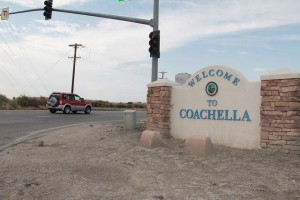
The Diary of Joaquín Magón Entry 22: The Deportation Chronicles, Part 1
The year 2012 has come to a close and the numbers of those removed from the United States are released – 409,849 individuals caught, trapped, nabbed, thrown into the patty wagon and kicked out with a boot – a record high.
For the Eastern Coachella Valley (ECV), it’s no surprise. It’s what makes the ECV so unique – the normalization, the desensitization of deportations. Think about that word. Deported. DE-POR-TED. It’s a horrible word and a horrible experience. To outsiders, the Coachella Valley conjures up fuzzy thoughts of a crazy concert or country clubs with golf courses and swimming pools.
But the Coachella Valley that I know is the Coachella Valley of deportation. The following are the stories of four people I am lucky to know. I am sharing their stories in an unconventional manner, over three installments of The Diary of Joaquín Magón. Hopefully, I will do them justice. Read on.
Mario Lazcano: Witness to the Scars of a Community
When it comes to immigration issues in the Eastern Coachella Valley, there is one person to see first: Mario Lazcano. Most know him as the guy who runs El Comité Latino and who works out of his cramped home, helping people with their immigration issues for practically nothing. Lazcano believes that the immigration/deportation issue in the ECV is a result of the authorities taking advantage of the fact that there is no solid leadership, no one organization or politician to defend the people.
To write about immigration today, would be to neglect a historical trend, since Secure Communities began in 2008 under the Bush Administration. Continuing under the Obama Administration, there has been a rise in deportations across the United States. But cities near the Mexican and Canadian border (ok, not so much the Canadian border) have had to deal with that rise for much longer.
There is a little known program called Operation Stone Garden, implemented in 2006, which provides grants for local law enforcement authorities that cooperated with border patrol agents. All of a sudden we started hearing stories of police calling ICE Agents on people they had pulled over, police asking for documents, and pretending it was a coincidence that the ICE agent showed up minutes after they had just pulled you over.
One man, as one story went, was forced to kneel on the side of the road by Los Duros trailer park before getting the back of his head blown off by a law enforcement officer internalized a fear of going outside. (This story could be true, partially true, or simply the result of rampant fear in the community.)
For the past six years, the ECV has been subject to multiple federal programs whose consequences have split families and caused a deep distrust of law enforcement. Sobriety checkpoints have become a way of taking cars away from undocumented immigrants.
Lazcano explains, “Because the Coachella Valley has been used as a testing ground…and that has caused us a lot of harm. That’s why talking about deportation and separated families is one of the most common things that we have experienced. Thank God that we haven’t gotten used to it.”
After that, a series of factors gave rise to a massive xenophobia across the United States – a bad economy, and a general acceptance of deportations as something necessary because immigrants were seen by people like Bill O’Reilly, as a social ill destroying America. This was also the time when a number of old and bored men with guns decided the “defend” the border with vigilante craziness. In December 2012, Rolling Stone writer Damon Tabor wrote:
“That a Phoenix crane load-rigger can point an assault rifle at two Guatemalan immigrants – and do so without consequence – is the product of two converging forces: Arizona’s long-standing anti-immigration culture, and a two-decade push by the federal government to shore up the Mexican border.”
The same can be argued for the Coachella Valley. Not in terms of the actually having those crazy nuts (at least I haven’t heard of any), but of accepting the fact that it’s just the way things are.
But for the year 2012 where, according to a statement by ICE Director John Morton, out of the 409,849 people deported “approximately 55 percent, or 225,390 …were convicted of felonies or misdemeanors – almost double the removal of criminals in FY 2008.”
But if 55 percent of the deportations had to do with criminals, and if the Obama administration ordered for criminals to be ICE’s focus, then what of the remaining 45 percent?
To Lazcano, this means that “[ICE] continues to hurt our families and harming our community and not following their own agreements that they wouldn’t deport us if we met certain criteria such as having a family and not having any serious criminal offenses.”
The individual stories behind those numbers are sad realities that fill Lazcano’s case files. A mechanic that drove from Coachella to Desert Hot Springs to pick up a car. His wife joins him; the police stops them. The police call the border patrol. They get sent to separate detention centers. Luckily, they were well informed and refused to sign for voluntary deportation. His wife, who had been sent to San Diego, was released; the husband was taken to Arizona and eventually released on bail. Now think of the family. They had an older son that protected his younger siblings, including a daughter that couldn’t understand why her parents couldn’t come home.
This Friday: The story of Mayte, an undocumented College of the Desert student who is among the thousands who have applied for Deferred Action for Childhood Arrivals.
_____
“The Diary of Joaquín Magón” is written by Jesús E. Valenzuela Félix, a reporter from Coachella living in Salinas and working for the United Farm Workers Foundation. He contributes regularly to Coachella Unincorporated.
